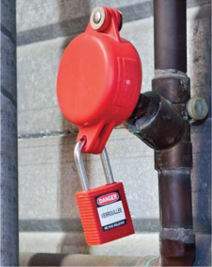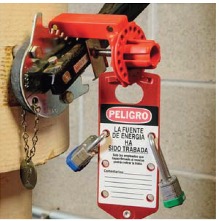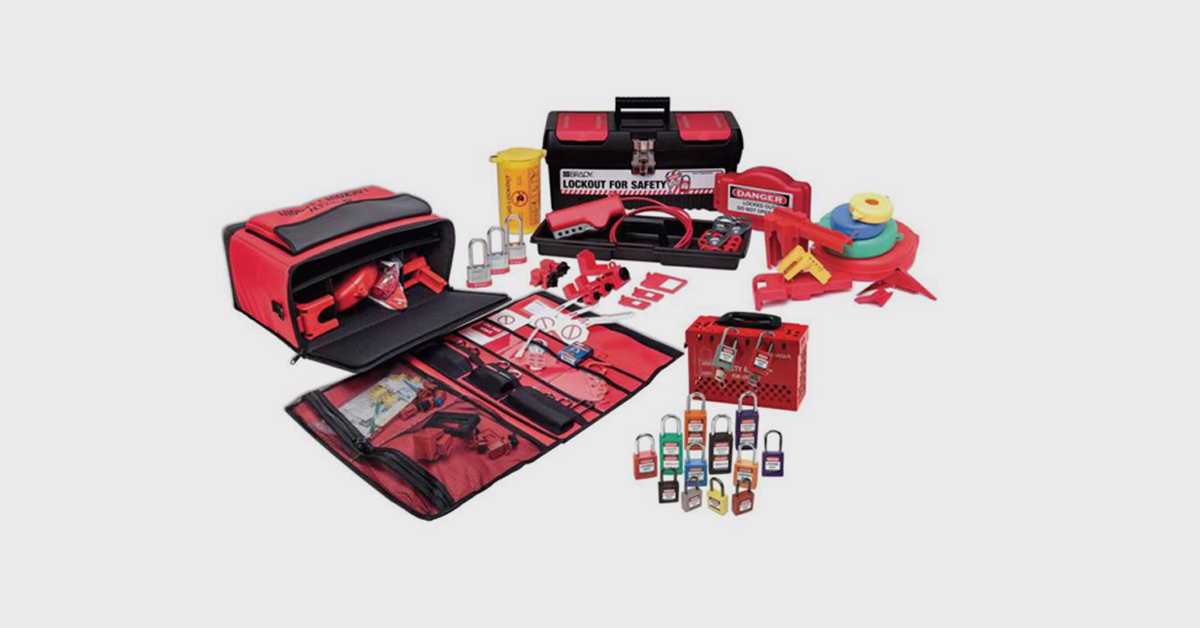Fall Protection, Work at Heights
Understanding the Basics of Lockout and Tagout
What Lockout / Tagout is:
When it comes to both life and business, energy matters! Whether it is wind energy, electricity, gasoline powered engines or the energy that fuels our bodies, we depend on energy to function. Energy, however, is extremely dangerous and even fatal when not controlled. Being able to switch a plug on so that you can heat a stove is great for creating a meal – Leaving that plug on when the cooking is completed could easily cause a catastrophe at home.
On the other hand, when we are at work a person dealing with maintenance may be servicing a mixing machine in the production line, he/she doesn’t want it to accidentally get turned on whilst changing one of the components.
If someone is cleaning a vessel and the water flow begins whilst in a confined space it could quickly become a deadly mistake.
That is the basis of lockout/tagout – All sources of energy that have the potential to unintentionally be activated, started or released must be identified and monitored. This is done through putting locks (lockout) or tags (tagout) to keep the power from being accidentally activated when it shouldn’t be.
What Lockout/Tagout is not:
Lockout/Tagout is not intended to deal with installation, maintenance and/or upkeep of generators, electrical utilities, generators, transmitters or conductors (though many will be transferable to these tasks). It is not intended to replace or even compliment electrical manuals or procedures.
Identifying all energy sources:
While electricity is the most common source of energy in the workplace, it is not the only one. All sources of energy need to be included in the lockout/tagout program for your company. Other sources of energy may include thermal, pneumatic, hydraulic, mechanical, chemical, gravitational or any combination of these.
For example: while a potentially harmful machine may have no more electrical current flowing through it, if a blade that is usually held in an “up” position is no longer able to stay in that position because the current was shut off, then gravity might become another energy source that would need to be identified and included in the lockout/tagout procedure. All energy sources must be identified and labelled accordingly. This is especially crucial for machines that have multiple sources of energy and/or machinery that may intermittently start and stop.
“A LOCKOUT / TAGOUT PROGRAMME MUST BE DEVELOPED AND ADHERED TO – GET IN TOUCH WITH YOUR PROTEKTA REPRESENTATIVE TO HAVE ONE DEVELOPED”
Establishing a lockout/Tagout program:
It is required for companies to have a written lockout/tagout program. This document must contain:
- The reasons why the written program is necessary.
- Clear step-by-step procedures involved in shutting down the machine(s), installing locks and tags and testing procedures to verify these procedures.
- Training for authorised personnel and anyone else who might directly or indirectly be involved or affected by this lockout/tagout procedure including any outside contractors.
Locks or tags?
Whenever possible, locks are to be used to prevent the power from being unintentionally turned back on. When locks are used, tags may serve as a backup, to further clarify the procedure.
The lockout/tagout industry has been able to come up with locks for almost all possible energy sources and a call to a safety professional should be enough to help you find a solution for your specific application.
 Both locks and tags must be clearly labelled as to the identity of the person who has applied them. This ID labelling is crucial so that only the person who applied the lock (the person who knows why the lock was put there in the first place) is the one to remove it. This prevents someone who may not have all the necessary information from taking an action that might prove detrimental to the person who put the lock there in the first place. If possible, both locks and tags should be locks and tags specifically designed for this procedure as they will have been designed to not be easily removed and to withstand the wear and tear of the maintenance work.
Both locks and tags must be clearly labelled as to the identity of the person who has applied them. This ID labelling is crucial so that only the person who applied the lock (the person who knows why the lock was put there in the first place) is the one to remove it. This prevents someone who may not have all the necessary information from taking an action that might prove detrimental to the person who put the lock there in the first place. If possible, both locks and tags should be locks and tags specifically designed for this procedure as they will have been designed to not be easily removed and to withstand the wear and tear of the maintenance work.
The writing on the locks and tags must remain legible until they are removed. Only authorised personnel should have the key for the lock on the control device and only authorised personnel should be permitted to lock out machines and equipment.
Group Lockout/Tagout:
When maintenance of a machine or piece of equipment is done by more than one person, it is advisable to implement a “Group Lockout/Tagout” procedure. A “Group Lockout/Tagout” procedure assigns a different lock to each employee working on the equipment so that the power cannot be restored until each employee has made it clear that they done with their assigned task by removing their own lock. This ensures that the power isn’t accidentally restored when one of the crew is still working.
 Example (Use picture below) – A supply valve is locked out when maintenance is performed in a tank which requires both the Boiler Makers (Blue Lock) and Cleaning department (Green Lock) to carry out their duty in the tank. Each person will be required to lock the System out to ensure only once all locks are removed is it safe to switch on the source of energy. In this example we would probably want one more lock, preferably a different colour, which would be the first connected and last removed. This would be the supervisor who will ensure the energy source is appropriately shut off, and only once they have ensured safe, switched back on.
Example (Use picture below) – A supply valve is locked out when maintenance is performed in a tank which requires both the Boiler Makers (Blue Lock) and Cleaning department (Green Lock) to carry out their duty in the tank. Each person will be required to lock the System out to ensure only once all locks are removed is it safe to switch on the source of energy. In this example we would probably want one more lock, preferably a different colour, which would be the first connected and last removed. This would be the supervisor who will ensure the energy source is appropriately shut off, and only once they have ensured safe, switched back on.
Conclusion:
Employers are responsible for the protection of all their employees. The requirements for lockout/tagout standards are:
- Establish a written, documented lockout/tagout procedure.
- Make certain all personnel are properly trained. This includes ensuring that authorised personnel know who they are, and others know that they do not have the authorisation to lockout or tagout.
- Identify all machinery and equipment which requires lockout/tagout
- Identify all energy sources on every single piece of equipment and machinery.
- Identify the most appropriate way to lock out each of the energy sources.
- Only tagout energy sources which CANNOT be locked out.
- Ensure that all locks and tags clearly identify the worker who put them on.
- Ensure that only the employee who put the lock or tag on is allowed or able to remove it.
- When all energy sources have been shut off and locked out or tagged, test them – try to manually turn the equipment on and check for any and all movement to ensure that there is no possibility that any of the parts can shift or move.
- Update all procedures and manuals at least once a year.
Practical Help on putting together an effective Lockout/Tagout Program
This process can seam quite daunting and technical but be assured there a specialists that focus on this and turn it into a fast and efficient process which should ensure the safety of your fellow work members as well as visitors to your facility.
Get in touch with your Protekta Safety Gear representative to assist with any stage of this process.


